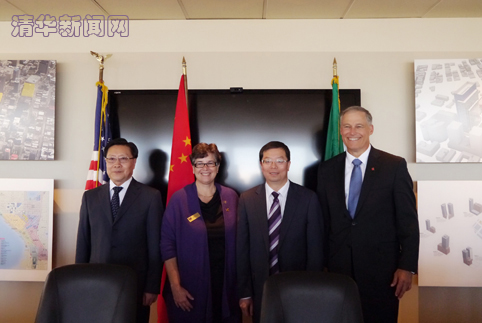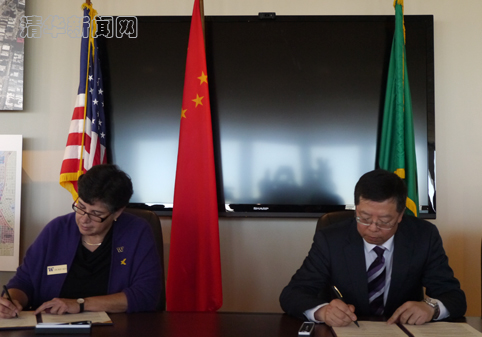Tsinghua University Cooperation with Sichuan, the University of Washington, and Washington State on Climate-Smart/ Low-Carbon Cities
----Exploring a new multilateral international cooperation model between universities and districts
Tsinghua University, together with China’s Sichuan province, are collaborating with the University of Washington and Washington state on “Climate-Smart/ Low-Carbon Cities” 2+2 Cooperation. The signing ceremony for the memorandum of understanding, called "2+2 MOU," was held in Seattle on September 22, local time.
Three months after a groundbreaking partnership between Tsinghua University, the University of Washington and the Microsoft Corporation on the Global Innovation Exchange Institute (GIX), which will pioneer new models of global teaching and learning, the state of Washington once again witnessed a more comprehensive and profound cooperation - Tsinghua University, together with Sichuan province in China, are collaborating with the University of Washington and Washington state on “Climate-Smart/ Low-Carbon Cities” 2+2 Cooperation, a novel multilateral international cooperation model between universities and districts, which to the fullest extent integrates the resources of the four parties. This model will drive forward relevant scientific research and industrial development, and promote the implementation of the “Climate-Smart/ Low-Carbon Cities Initiative” between China and the United States. It will also facilitate the deepening of reform and opening up, as well as the transformation of economic development in central and western areas in China. The cooperation model of “2+2” advances the partnership between universities and districts, which is also the first profound international cooperation of its kind ever held in China.

A memorandum of understanding, called "2+2 MOU," was signed between Tsinghua University and the University of Washington, as well as Sichuan province in China and Washington state in the U.S. in Seattle on September 22nd.

Tsinghua University President Qiu Yong, University of Washington Interim President Ana Mari Cauce, Party Secretary of Sichuan province Wang Dongming, Governor of Washington state Jay Inslee, and Tsinghua Vice President Yang Bin attended the ceremony.
“This partnership aims to tackle global challenges, in particular energy issues and environmental problems confronting human beings. It will also be part of a wider effort to integrate university-led initiatives to the government and society as a whole,” said Tsinghua University President Qiu Yong.
“Leading research universities, such as the University of Washington and Tsinghua University, have a vital role in helping develop not just the technologies, but the policies and public awareness needed to create a more sustainable future,” said UW Interim President Ana Mari Cauce.
This memorandum of understanding follows last year's China-US Joint Announcement on Climate Change, signed by Chinese President Xi Jinping and U.S. President Obama, in which the two countries decided to launch a Climate-Smart/Low-Carbon Cities Initiative.
Extensive cooperation has been carried out between Tsinghua University and the University of Washington on climate change and energy internet. The “Climate-Smart/ Low-Carbon Cities” 2+2 Cooperation agreement marks a further and deeper development of the partnership between the two universities. The establishment of international cooperation between universities and districts also embodies the social responsibilities and contributions of a university in meeting global challenges and promoting districts’ scientific and economic development.
Tsinghua University is a leading research and education institution in China. It has strengths in low carbon energy technology research and development, and is also a major think tank for China’s energy and climate policy making. The university has created the Laboratory of Low-Carbon Energy, with research programs under which include nuclear energy, renewable energy, smart grid, low carbon mobility, and policy. Recently, the university has also established a new research center for energy internet – The Energy Internet Research Institute, which leverages profound work based in the fields of energy and information technologies.
The University of Washington is the third highest recipient of science and engineering research funding in the U.S.A. The faculty are among the most highly cited global scholars in materials chemistry, physics, and engineering. The University has extraordinary breadth of research into the cyber-physical systems that will underpin the next generation clean energy economy, as well as key environmental sciences, planning, and policy expertise to advance the global development of climate-smart/low-carbon cities. The Clean Energy Institute and its research and corporate partners not only understand the fundamentals of clean energy science, but also translate that knowledge into technologies and companies that can scale-up to achieve a low carbon future.
Sichuan Province, located in western China, is an important conjunction region of the “One Belt and One Road” and the “Yangtze River Economic Zone” development strategies. Sichuan has a long tradition of advanced commerce and a prosperous economy throughout its history. It occupies one-fifth of the total economic size of the 12 provinces (cities and districts) in western China by all major economic indicators. Sichuan plays a very significant role in China’s development in terms of economy, resources and technology. Sichuan has been a leading province for low carbon energy economy transformation in China. The Province has abundant low carbon energy resources, and is currently the largest producer of hydro power and shale gas in China, and also a leading province for solar energy and biomass development and utilization.
The State of Washington has been the leading producer of clean, low carbon energy in the U.S.A. for about seven decades, and is host to the largest smart grid demonstration project in the U.S.A..The State incubates and attracts global corporations, funding, and partnerships for research and development activities tied to clean energy forecasting, clean energy materials and manufacturing, grid technologies, low carbon transportation, biofuels, marine energy, and the assessment of environmental impacts from energy production and use. The State’s extraordinary information technology companies, manufacturing companies, research and educational institutions have positioned the state of Washington as a leader and premier partner for the development of next generation clean energy technologies, planning, and policies that will underpin the next generation of climate-smart/low-carbon cities.

